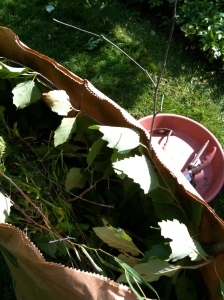When she first told me her apartment complex was off NICE road I thought I heard ‘a nice road’. “Oh, great!” I replied, trying to show enthusiasm for surface pavement, “But what is the name?”
“NICE”, she said again, “The toll road, about 3 kilometers from Electronic City.”
There is a lot of ambiguity in India but I can’t say the same for subtlety, especially when it comes to new development. California County, Wall Street II, Prestigious White Meadows, Dream City…these are just a handful of communities I have come across in the past week.
Like many former British colonies, English street names and districts are common in urban India (e.g. Richmond Town, Frazier Town) but it seems, to me at least, that there might be a correlation between the liberalization of India’s economy and the rise in gated communities that make literal references to lifestyles specific to particular geographies. J. Naigar’s and John Stallmeyer’s excellent works on Bangalore helped me understand the city’s explosive growth, particularly in terms of human population and kilometers of land but neither prepared me for the flood of speculative real estate development I have encountered.
Some highlights below:
-Billboards testimonials. These are particularly popular along Bellary Road, from the airport into the city, but also on any toll road—such as the NICE ring road. These testimonials include a picture of an individual in some expressive gesture, such as a head cocked to one side. “I chose to relocate from _______ to Bangalore, and it was the wisest decision I’ve ever made.” A simple, straightforward affirmation. The logic of someone beyond middle age. It seems to recall Bangalore’s former identity as a ‘pensioner’s paradise’, namely because of the year-round good weather. The word is relocate, but the assumption is retire. Retire and invest.
-Radio. “Ooh gawd, Shriti,” begins one radio ad I heard approximately every five minutes for one entire weekend, “I’ve missed the real estate expo and now I’m back to driving all across the city looking at places.”
“Don’t worry Ashita, the expo has been extended for one week more!” Like all classic infomercials, we are told to ‘hurry’ because this ‘opportunity’ ‘won’t last.’
Another personal favorite is one in which a metaphor between finding the perfect wife and finding the perfect property is utilized. By doing his research, and refusing to settle for anything less than perfect, the man gets both the woman and the two-bedroom flat.
Or, here are some favorite snippets from the August 23rd real estate section of the Times of India (Bangalore edition):
Toast, Cereals and Conversations: Nitesh Cape Cod is located just off the Sarjapur-Marathahalli Ring Road and within walking distance of leading IT offices.
-Niteshestates.com
Get ready to Start your Second Innings at your Own British Colonial Bungalow (sic): Fresh forest oxygen; Zero carbon footprint
-legacyhomes.in
Innovative aquafront: Where happiness Reflects. Exactly Facing the Lake
-innovativeconstructions.in
-Comment: This is not EXACTLY what I would call a Lake, nor is it exactly attractive.
Neo Bangalore—An Address you can flaunt about
Your property can help you fulfill your dreams, just like your family.
-HSBC
Even since my trip here last summer I feel what was a craze has now become an epidemic. That said, it’s hard to know what is aggressive advertising and what is reality. As an employee working in Electronics City, I’m amidst the target population of this advertising. And yet real estate has yet to become the topic of any lunchtime conversation. So is this ‘Exactly facing the Lake’ this ‘Toast, Cereals and Conversation’ a myth?
Regardless of whether or not Innovative aquafront actually faces a lake the reality of this city is uneven development. Bangalorians often talk about how just 20 years back all this area was scrubland. Aside from being called a pensioner’s paradise, Bangalore was also—and is still somewhat—referred to as India’s ‘Garden City’, an image the real estate industry loves to invoke. But can the legend of Bangalore’s garden paradise peacefully co-exist with the reality of high population growth? Can the city successfully attract people, development, and maintain ‘pristine natural surroundings’?
The directions for getting to my co-worker’s apartment were simple. After getting off the NICE toll road I was to turn left at the petrol station and continue down the winding road until I arrived at ‘Sabah Sunscape’.
The thing was, after a few hundred yards from the petrol station the road went from paved, to dirt, and then back to paved. We passed cows, pockets of dense forest, and area cleared for future development. We came to a fork in the road. The driver stopped a man in a white dhoti who seemed to be walking without purpose. “Where is Sabah Sunscape?” he asked in Kannada. The man gestured straight with a good deal of indifference. After a few minutes we came to a gate and two high rises. I got out of the rickshaw and walked toward the security station on the other side of the gate and told the guard the name of my friend. He checked the roster and shook his head. No one of that name lived there. After a few minutes of debate we solved the problem. I was at Sabah Sunbeam, NOT Sabah Sunscape. I walked back to the rickshaw. We continued driving until we finally arrived at an even larger gate set between two concrete pillars. We had arrived at Sabah Sunscape.
Later that night, coming back to Electronics City, I started to wonder what makes a city. If Electronics City does not include electronics manufacturing nor does it constitute an actual city, why does it have the name that it does? Electronics City is supposedly the ‘place’ that put Bangalore in the global marketplace, but for the first 15 years of existence it was considered to be outside the city. Now, Bangalore’s development stretches even further south. Was Sabah Sunscape and its environs really part of this Bangalore city? Historically, Bangalore has always been a low-density city. But that did not mean, I thought to myself, that some gated high-rise apartments located in the middle of nowhere could be part of the city, even if the city boundary will eventually give way and include it. Then again, what right did I, a child of Detroit, have to conclude what is urban and what is not?
Is urban the same thing as city? What is a city anyway?
Sometimes my grandfather likes to tell us about the first house he and my grandmother bought. The street on which the house was built wasn’t completed; they were the first homeowners on the block and because of this, my grandmother got to name the street. She chose ‘Devonshire’ because she thought is sounded very sophisticated.
It’s easy to be cynical of the HSBC quote about family and property, but the fact is that for many people this relationship and its connection to something loosely defined as a dream is very much a reality. Cities are also spaces/places of dreams, or where people go to fulfill something that might be described of a dream. Cities are constantly expanding in order to accommodate all those individuals, all those families, and all those dreams. So, I suppose when I think of it that way I can accept Sobha Sunscape as part of Bangalore and yet, when it comes to the reality of this piecemeal development, these self-contained bio-spheres of swimming pools and tennis courts cropping up in the middle of nowhere, claiming to have the amenities of both urban and suburban life I can’t help but think that these real estate dreams must be destroyed, as the future of the city depends on it.





 “There’s something soothing about seeing an even expanse of green grass that just seems to lower our blood-pressure a bit.”
“There’s something soothing about seeing an even expanse of green grass that just seems to lower our blood-pressure a bit.”